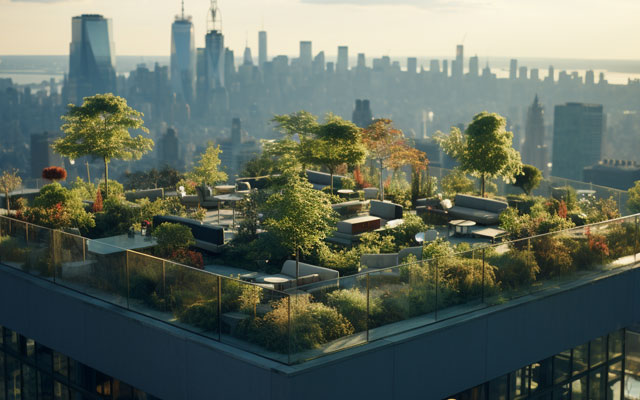research
Regenerative design: cities as generators of environmental health
‘Regenerative Design’ is a concept aiming to help us transform our relationship with the planet and innovation is at its heart.
The world continues to grapple with ways to limit our impact on the planet. As the clock begins to tick louder and louder, we need to innovate faster and align more closely with natural systems. Not only sustain but regenerate. ‘Regenerative Design’ is a concept aiming to help us transform our relationship with the planet and innovation is at its heart. But what does it mean in practice?
From sustainability to regeneration
The term ‘sustainability’ was used for the first time in a United Nations document in 1978 and has since evolved to cover not only technical but also economic and policy related issues. Unfortunately, the intense evolution in terminology has not been matched by equally widespread implementation of solutions bringing this concept to life. Undoubtedly there has been some progress, evidenced by increased numbers of wind turbines, solar panels and buildings awarded BREEAM/LEED certification, but in general, ‘sustainability’ fell prey to ‘a lot more of conversation, a lot less action’. As such, the essential principle of sustainability - limit the negative consequences to the existing environment – will no longer suffice as environmental / climate action. The world must start doing more than just minimising the harm and instead start regenerating what was present or generate what should, in principle, be there.
Regenerative design – is it just a Sustainability 2.0?
The essential difference between sustainability and regenerative design is that the latter focuses on creating built environments in which humans are embedded in nature – and as such, not only is there no environmental damage, but the natural environment is enhanced by anthropological activity. A separate set of activities concerns already existing dwellings, which need to be modified in order that they meet the same criteria (this brings some challenges that we discuss later).
The world must start doing more than just minimising the harm and instead start regenerating what was present or generate what should, in principle, be there.
The term Regenerative design harkens from around 1994, when John Tillman Lyle used it1 in the context of sustainable urban development, but the concept itself is much older. Our ancestors in ancient cities such as Mohenjo-daro in the Indus Valley were already aware that their dwellings should be self-sustaining, regenerative and resilient – and they achieved it through a complex system2 of wells, drainage channels and reservoirs. Fast forward to 20th century and you will find the call to work with nature rather than against it coming from pioneers such as Buckminster Fuller3 and Ian McHarg. The concept began re-emerging in the last few years, triggered by the elevated climate emergency and it appears to be gaining traction.
Are we ready for this transition?
One of the concerns around Regenerative design is that it becomes another ‘hype’, much spoken about, triggering visions of the future that are never realised due to lack of action. But there are reasons to be hopeful that the current efforts will indeed be different. In 2019 Architects Declare initiative was launched, calling for a paradigm shift that will enable the design of buildings, cities and infrastructures as indivisible components of a larger, constantly regenerating and self-sustaining system – not as isolated assets, as this has often used to be the case. Top global architectural practices committed to adopt more regenerative design approach practices, minimise wasteful use of resources in architecture and urban planning, and establish climate and biodiversity mitigation principles as the key measure of industry’s success. Soon after, engineering consultancies and contractors followed the suit. It appears that a possible change is in the air – as evidenced by the recent increase in the case studies and publications from major engineering consultancies focused on the nature-based solutions (NBS). For example, Arcadis is collaborating with the Leeds City Council to deliver nature-based solutions and natural flood management interventions throughout the 700km2 Upper River Aire Catchment. Arup, on another hand, as part of the enhancement scheme to restore the Cornish countryside led by Highways England, designed green infrastructure corridors following valleys, emanating like ribs from the spine of the A30. This is a good start, but even more could be achieved if architects and engineers joined forces with biologists and biotechnologists. However, before we start exploring the world of possibilities, we need to answer some basic questions.

Regenerative – but what does it mean in practice?
Firstly, we need to agree what is it that we are regenerating? Many would be tempted to respond “our planet!” but it would be difficult to visualise interventions that would impact the whole planet when applied locally. Hence, perhaps we should be focusing on our local environments, districts, possibly cities – in other words, eco-systems. This is important distinction, since sustainability has often been addressed on a case-by-case basis, – resulting in a number of high-performing buildings scattered among our cities. Regenerative interventions can of course be applied to a single asset, but their purpose is to impact an entire system. As such, the ‘systems thinking’ concept (ie. investigating what set of factors and interactions are contributing to or could contribute to a possible outcome) is a must. It is a concept already familiar to most biologists and is discussed more and more often in the built environment field, especially with the development of nature-based solutions. After all, the reference to ‘ecosystems’ is embedded in the NBS definition.
Then comes the question of defining the final outcome - a regenerated ecosystem. This will require establishing some criteria and asking what is it that we are striving for. It may seem straightforward but let’s consider this using an example of two potential measures – a biodiversity index and pollution index. We can measure them now and we can probably extrapolate to estimate what their values were in the past – 50, 100, 200 years. The question is, are we aiming to re-create the eco-systems as they were hundreds of years ago? Would that be even possible, with all the associated contemporary human activity? Or should we rather aim to design systems which can accommodate for urbanisation AND still create positive impact?
In the biology and ecology area, the powerful combination of data and AI/ML can aid the design of ecosystems, pointing to the organisms that will be the best match and will enhance biodiversity most effectively.
Last, but not least, the extended version of a regenerative design definition mentions six categories where net-positive impacts should be observed: Carbon, Water, Nutrients, Air, Biodiversity, Social and health categories. This is a combination of human and nature’s needs – since regenerative design sees humans as ‘embedded’ in nature, rather than on top of the pyramid of species. But is everything that would help regenerate nature in line with ‘social and health’ category? And if not, what do we do to achieve as a minimum a similar effect?
These are just few examples of issues that are not yet clearly defined in the regenerative design space – and there will be more and more appearing as we go. But rather than suspending any action for the next 10 years, we should amplify our research efforts and even more importantly – relentlessly test and pilot new solutions. There are already many tools at our disposal that can help us design, build and operate in a net-positive manner.
The tools that we have…
We have already established that one of the biggest challenges of regenerative design is the shift to systems thinking. The good news is, we do have the digital capabilities not only to gather, store and analyse immense amounts of data, but also to use it for modelling and predictions. Hundreds of design solutions meeting multiple criteria can now be explored with the use of generative design, including work on multiple assets. Building information modelling (BIM) helps engage multiple stakeholders and streamline planning and delivery, and digital twins opens venues to more effective maintenance. In the biology and ecology area, the powerful combination of data and AI/ML can aid the design of ecosystems, pointing to the organisms that will be the best match and will enhance biodiversity most effectively.
But regenerative design involves working directly with nature and we already see some examples. Consider, for example, the attempts to use more timber in our buildings or employing green infrastructure solutions into our cities, either to help manage the rainfall or to mitigate the effects of extreme heat. Green walls and green roofs are some of the solutions gaining more traction and they create benefits, albeit at just a fraction of their full potential. With the application of synthetic biology, they could be used more efficiently in their traditional applications and address new challenges such as, for example, air pollution.
Even more could be achieved if architects and engineers joined forces with biologists and biotechnologists.
To achieve true regeneration, we also need to keep looking for ways to employ natural solutions more broadly. Methods like bioremediation (ie. the use of naturally occurring microorganisms to break down environmental pollutants) or phytoremediation (ie. the use of plants to clean up contaminated water, soil or air), despite being established, are often perceived as insufficient. Sadly, this is true, since the levels and or the nature of the contamination often exceed the capacity of ecosystems to handle it11. Nevertheless, we are aware of multiple microorganisms and their positive functionalities, such as purifying water, breakdown of plastics, turning waste into valuable products. We can now use AI/ML to both aid selection of the best solutions and to model how it will perform in the built environment. By applying synthetic biology / engineering biology, the desired biological functionalities can be enhanced and these novel processes can be scaled up. AI/ML can then be used again to verify the progress in regeneration and possibly optimize either the process or the elements of the environment in which it is being deployed. Thus, there is a good foundation for a regenerative design approach. But if we are to deliver this concept successfully, we need to continue innovating, across various inputs – technology, but also skills, regulations, and business models.
Table 1. Examples of challenges and potential mitigations through regenerative actions
Challenges in
our cities
- Concrete and asphalt interfering with (rain) water absorption and regulation
- The prevalence of concrete and glass on buildings/roads contributes to the heat islands effect
- Nature insufficient to help regulate water cycle
- High density of buildings limits natural light and air movement
- Transport adding to noise and air pollution
- Energy inefficient buildings
- Increasing human population leads to growing waste streams
- Nature in pockets, isolated, unable to work as a broader ecosystem
- Soil pollution on brownfield sites making them unusable
- ‘Low biodiversity’ - limited species cultivated in city conditions
Possible regenerative
actions
- Structures made of bio-cement grown by bacteria using CO2 and waste
- Carefully positioned trees limit heat island effect and create connectivity between natural spots
- Green walls with carefully selected plants help purify air and create sound barrier
- Algae systems embedded in facades purify water, absorb solar energy and produce biomass for making biogas
- Microbial fuel cells on rooftops use organic waste, purify water and produce energy
- Bio-receptive materials on bridges, walls etc. promote the growth of nature
- Combination of rooftops creates natural corridors above our heads, with AI ‘advising’ on the type of plants to grow
- Buildings harvest rainwater and AI distributes it according to demand, including to aquaponics
- Plants with bioremediation functionality helping to clean brownfield sites
- Grasses and AI selected plants on railway track and highway slopes preventing water and nutrients run-off
Methods like bioremediation (ie. the use of naturally occurring microorganisms to break down environmental pollutants) or phytoremediation (ie. the use of plants to clean up contaminated water, soil or air), despite being established, are often perceived as insufficient.
…and the research that we need
Research opportunities are abundant – from scaling up the existing biological solutions and enhancing their effectiveness to looking for new solutions in nature – and how to apply them in a human dominated environment. There is enormous potential to develop innovative technologies, processes, and materials.
But research needs to go hand in hand with innovation in other areas. Adjustments to safety regulations need to be considered to enable application of solutions that include living organisms. Our ‘return to nature’ will need to be examined diligently to ensure there is a net-positive impact to both humans and surrounding ecosystems.
We must also reconsider our requirements for the built assets, including possible shortening of asset lifespan in favour of circularity or bio-based and/or biodegradable solutions. This will have implications on the traditional business models from consideration of supply chains through physical makeup and design of the built environment itself. We already see attempts to turn buildings into ‘material banks’. Some traditional fixed asset elements could also be turned into services, for example ‘roof as a service’ or ‘façade as a service’ could open opportunities for companies specialising in green roofs or walls.
Our ‘return to nature’ will need to be examined diligently to ensure there is a net-positive impact to both humans and surrounding ecosystems.
To improve our relationship with nature we need a blend of natural solutions and human derived digital technologies. This means that we also need people with a new set of skills, capable of translating between the natural and built environments and fluent with data and digital technologies. For the construction industry, suffering from a lack of new recruits, this can be a breath of fresh air, attracting young people willing to work on projects that have a visible – positive – impact. For biology and biotechnology students and specialists, new pastures are likely to open through collaboration with architects, building engineers, urban planners etc. The future looks exciting.
Regenerative design is within our reach. The challenges it brings offer a perfect opportunity to work on innovative multidisciplinary solutions that while healing our relationship with the planet will, simultaneously, provide a chance to boost our economy via novel capabilities and skills, and improve urban health and well-being. Let’s just not get tangled in discussions about the terminology…
References
1. Lyle, J. T. Regenerative design for sustainable development / John Tillman Lyle John Wiley New York 1994
2. Jansen, M. Water supply and sewage disposal at Mohenjo‐Daro. World archaeology 21.2 (1989): 177-192.
3. Wahl, D. C. Regenerative Design and a Science of Qualities. Netw. Rev. Sci. Med. Netw 2, 2016, p12-14.

Brendon Noble FRSA, FRSB, FIKE
Head of the School of Life Sciences
Director of the Institute for Healthy Urban Living (IHUL)
Professor of Regenerative Medicine
School of Life Sciences,
College of Liberal Arts & Sciences,
University of Westminster.

Dr Agnieszka Krzyzaniak
Global Research Manager at Arcadis, specialising in market research, including the latest trends and their possible impact on both construction and built environment. An experienced researcher, she has over 10 years’ experience working with multiple engineering consultancies, including Royal HaskoningDHV and Arup. Agnieszka’s background in biotechnology makes her a passionate advocate for bio-based solutions, and she is interested in exploring how digital technology can help built environment become more sustainable.